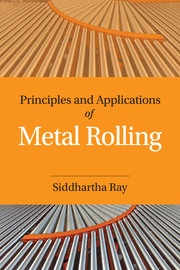4 - Rolling Equipment and Systems
Published online by Cambridge University Press: 05 June 2016
Summary
Various types of equipment and systems are used in a rolling mill. The major equipment is obviously the mill stand in which the material is actually rolled between two or three rotating rolls. Apart from the mill stand along with its own different mechanisms and systems for rotating the rolls, positioning the rolls to effect amount of reduction on the stock, to guide the stock in perfect position and orientation with respect to the rolls, etc., various other equipment and systems are necessary based on the rolling process (hot or cold), size and shape of input stock, specifications of product mix, desired quality of the products, and handling of the rolling stock up to finished product stage. These are called auxiliary equipment.
In this section, for each of these equipment and systems the functions, constructional features and specifications and in some cases the basic design features and calculations have been discussed. The design aspects will be limited to mechanical design. Electrical drive, controls and instrumentation plays a very important role in modern rolling mills. A brief section has been devoted to these but their design aspects are beyond the scope of the present treatise.
Mill Stand Components and Mechanisms
Most type of rolling mill stands have certain common basic components, mechanisms and systems. These are:
(i) Work rolls between which rolling takes place.
(ii) Backup rolls to support work rolls, excepting in case of 2-Hi, 3-Hi mills or cluster mills.
(iii) Roll supporting bearing and bearing blocks (chocks).
(iv) Roll positioning (or screw-down) mechanism which alters the gap between the work rolls.
(v) Roll balancing arrangement which keeps the set of top work and backup rolls in position and does not allow the top work and back-up rolls to come down and touch bottom work roll when there is no stock in roll bite.
(vi) Mill housings (generally a pair for normal 2-Hi, 3-Hi, or 4-Hi mills) within whose windows the roll bearing chocks are supported and allowed to be slided up and down during screw down adjustment.
(vii) Base Plates (also called shoes) in the form of two girders onto which the housings are fixed. The base plates are mounted on the foundation.
- Type
- Chapter
- Information
- Principles and Applications of Metal Rolling , pp. 168 - 290Publisher: Cambridge University PressPrint publication year: 2016



